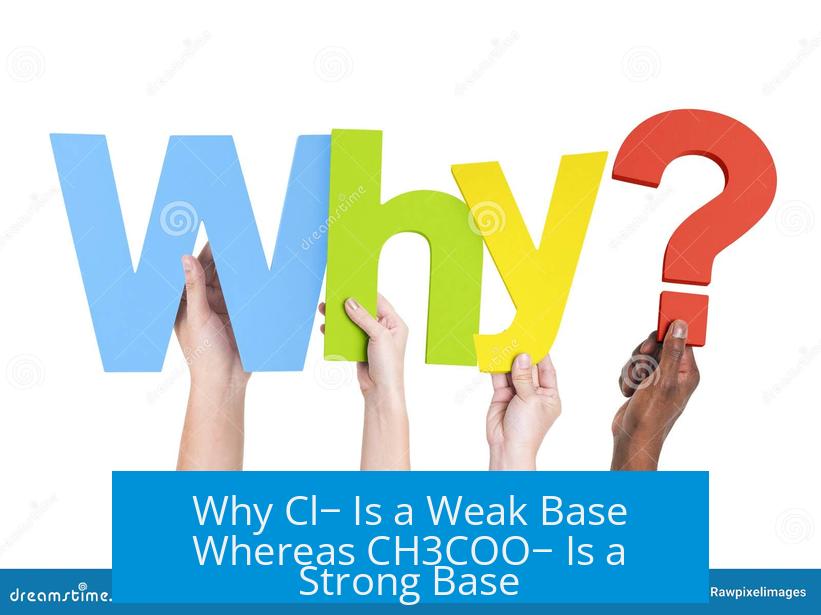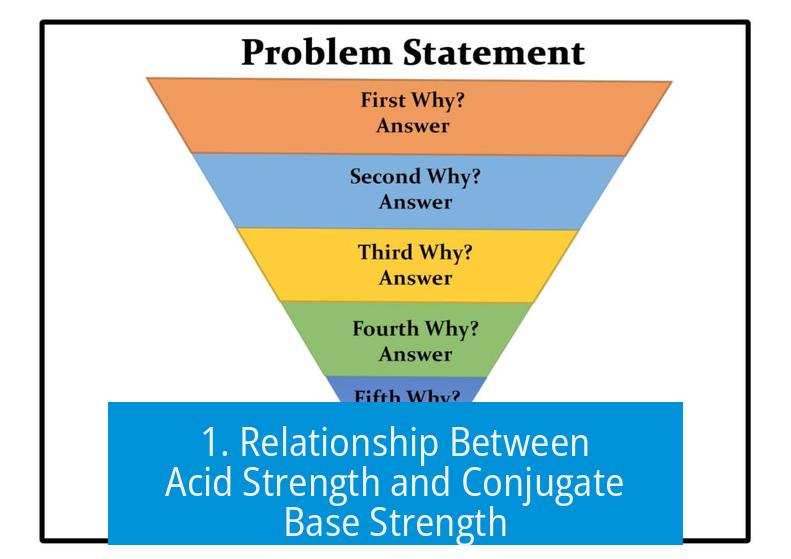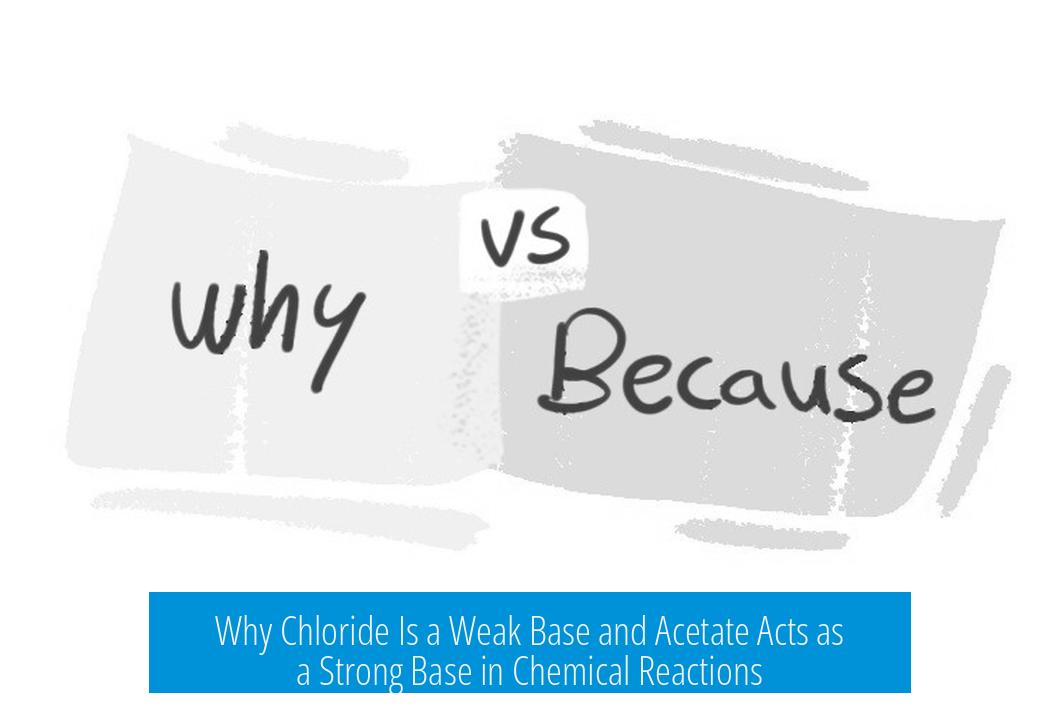Why Cl− Is a Weak Base Whereas CH3COO− Is a Strong Base

Cl− is a weak base because its conjugate acid, HCl, is a strong acid, making the chloride ion very stable and unlikely to accept protons. In contrast, CH3COO− is a stronger base since it is the conjugate base of the weaker acid acetic acid (CH3COOH), allowing it to partially react with water and generate hydroxide ions, thus displaying basic behavior.
1. Relationship Between Acid Strength and Conjugate Base Strength

Base strength closely correlates with the strength of its conjugate acid. Hydrochloric acid (HCl) is a strong acid with a very low pKa (around −7), meaning it dissociates completely in water. Its conjugate base, the chloride ion (Cl−), has little tendency to bind a proton. This is because strong acids produce very weak bases.
Acetic acid (CH3COOH), on the other hand, is a weak acid with a pKa near 4.76. Its conjugate base, acetate ion (CH3COO−), is comparatively stronger because acetic acid does not dissociate fully, resulting in a greater equilibrium concentration of the conjugate base form. Consequently, CH3COO− can act as a base more readily than Cl−, albeit still classified as weak in absolute terms.
2. Stability of Chloride Ion Leads to Low Basicity
The chloride ion is highly stable due to its closed electronic shell configuration after gaining an electron. This stability, characterized by low potential energy, means it does not seek to share electrons again with a proton. As a result, Cl− has minimal tendency to accept protons, rendering it essentially a non-base under typical aqueous conditions.
In energetic terms, the chloride ion achieves a favorable low-energy state after dissociation, so chemical equilibria do not favor its protonation back to HCl. Therefore, despite being an anion with a free electron pair, it remains chemically inert toward proton acceptance.
3. Acetate Ion’s Interaction with Water and Basic Behavior
Unlike chloride, acetate ion interacts with water to some degree through the reaction:
CH3COO− + H2O ⇌ CH3COOH + OH−
This equilibrium produces hydroxide ions (OH−), which increase the solution’s pH and manifest basic characteristics. The reaction demonstrates that acetate ion can accept protons from water, shifting the balance toward acetic acid and hydroxide ion formation.
This partial hydrolysis is absent or negligible for chloride ions due to their stability and the higher acidity of HCl. Therefore, the ability to generate OH− is a key factor differentiating the basic strength of acetate and chloride ions.
4. Acid-Base Equilibria and pKa Values Explain Basic Strength Differences
| Species | Conjugate Acid | pKa (Conjugate Acid) | Basicity of Conjugate Base |
|---|---|---|---|
| Cl− | HCl | −7 (very low) | Very weak / non-base |
| CH3COO− | CH3COOH | 4.76 (moderate) | Weak base (stronger than Cl−) |
The strength of an acid is inversely related to the strength of its conjugate base. A lower pKa value means stronger acid and weaker base. Hydrochloric acid’s low pKa results in the chloride ion being a non-basic species. Acetic acid’s higher pKa yields a conjugate base with greater electron density available to accept protons.
5. Electronegativity Is Not a Reliable Predictor of Basicity
It may appear that chlorine, being less electronegative than oxygen, should make Cl− the stronger base. However, electronegativity is an inadequate metric for predicting proton affinity or base strength because basicity involves a species’ ability to accept protons rather than simply holding electron density.
For example, fluoride ion, with even higher electronegativity, is not the strongest base despite its enhanced electron density. Basicity depends more on the stability of the conjugate acid, solvation effects, and equilibrium constants rather than atomic electronegativity alone.
6. Absolute Basicity Scale: Both Are Weak Bases
While acetate ion is stronger as a base compared to chloride ion, both are weak bases when placed on an absolute scale. For instance, hydroxide ion (OH−) and carbonate ion (CO32−) display significantly stronger basicity than acetate. Chloride ion typically behaves as a spectator ion in acid-base reactions.
In aqueous systems:
- Cl− does not meaningfully raise pH or generate OH− ions.
- CH3COO− can slightly raise pH by shifting equilibrium to produce OH− ions.
This difference is fundamentally controlled by the acid dissociation tendencies and stability of ions involved.
7. Summary Table: Basis of Relative Basicity
| Ion | Conjugate Acid Strength | Ion Stability | Ability to Accept Proton | Resulting Basicity |
|---|---|---|---|---|
| Cl− | Strong acid (HCl) | Highly stable, low energy | Very low | Weak base / Non-base |
| CH3COO− | Weak acid (CH3COOH) | Moderate stability | Moderate (partial proton acceptance) | Weak base (stronger than Cl−) |
8. Practical Implications in Chemistry
Understanding why Cl− is a weak base and CH3COO− is a stronger base is vital when predicting behavior in solution, especially in acid-base equilibria. The tendency of acetate to generate hydroxide ions makes it useful in buffering systems, maintaining pH stability. Chloride ions, by virtue of their minimal basicity, largely remain spectators in such systems.
This knowledge helps to design buffer solutions, understand reaction mechanisms involving proton transfer, and rationalize the stability of salts and acids in water.
Key Takeaways
- The base strength of Cl− and CH3COO− depends on their conjugate acid strength—HCl is a strong acid, acetic acid a weak acid.
- Cl− is a more stable ion with low driving force to accept protons, so it acts as a non-base.
- CH3COO− is less stable and can partially react with water, yielding OH− and showing basic behavior.
- Acid-base equilibria and pKa values explain differences in basicity between conjugate bases.
- Electronegativity does not directly predict basic strength in proton acceptance.
- Both ions are weak bases absolutely, but acetate is quantitatively stronger than chloride.
- Knowledge of this difference is crucial in acid-base chemistry, buffer formulation, and reaction pathway predictions.





Leave a Comment